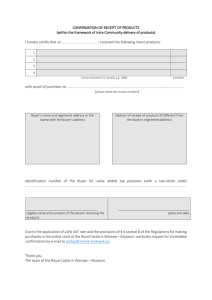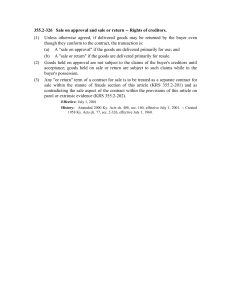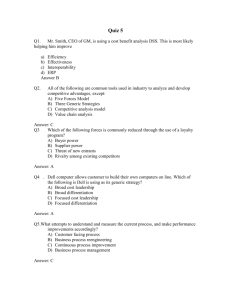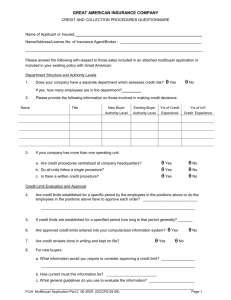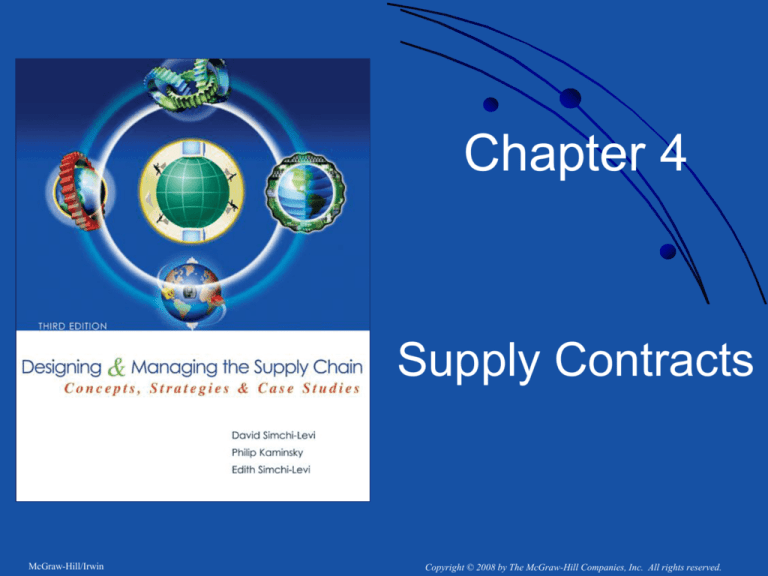
Chapter 4
Supply Contracts
McGraw-Hill/Irwin
Copyright © 2008 by The McGraw-Hill Companies, Inc. All rights reserved.
4.1 Introduction
Significant level of outsourcing
Many leading brand OEMs outsource complete
manufacturing and design of their products
More outsourcing has meant
Search for lower cost manufacturers
Development of design and manufacturing expertise
by suppliers
Procurement function in OEMs becomes very
important
OEMs have to get into contracts with suppliers
For both strategic and non-strategic components
4-2
4.2 Strategic Components
Supply Contract can include the following:
Pricing and volume discounts.
Minimum and maximum purchase
quantities.
Delivery lead times.
Product or material quality.
Product return policies.
4-3
2-Stage Sequential Supply Chain
A buyer and a supplier.
Buyer’s activities:
generating a forecast
determining how many units to order from the supplier
placing an order to the supplier so as to optimize his
own profit
Purchase based on forecast of customer demand
Supplier’s activities:
reacting to the order placed by the buyer.
Make-To-Order (MTO) policy
4-4
Risk Sharing
In the sequential supply chain:
If the supplier shares some of the risk with the
buyer
Buyer assumes all of the risk of having more inventory
than sales
Buyer limits his order quantity because of the huge
financial risk.
Supplier takes no risk.
Supplier would like the buyer to order as much as possible
Since the buyer limits his order quantity, there is a
significant increase in the likelihood of out of stock.
it may be profitable for buyer to order more
reducing out of stock probability
increasing profit for both the supplier and the buyer.
Supply contracts enable this risk sharing
4-5
Buy-Back Contract
Seller agrees to buy back unsold goods
from the buyer for some agreed-upon
price.
Buyer has incentive to order more
Supplier’s risk clearly increases.
Increase in buyer’s order quantity
Decreases the likelihood of out of stock
Compensates the supplier for the higher risk
4-6
Revenue Sharing Contract
Buyer shares some of its revenue with the
supplier
in return for a discount on the wholesale price.
Buyer transfers a portion of the revenue
from each unit sold back to the supplier
4-7
Other Types of Contracts
Quantity-Flexibility Contracts
Supplier provides full refund for returned
(unsold) items
As long as the number of returns is no larger
than a certain quantity.
Sales Rebate Contracts
Provides a direct incentive to the retailer to
increase sales by means of a rebate paid by
the supplier for any item sold above a certain
quantity.
4-8
Global Optimization Strategy
What is the best strategy for the entire
supply chain?
Treat both supplier and retailer as one
entity
Transfer of money between the parties is
ignored
4-9
Global Optimization and Supply
Contracts
Unbiased decision maker unrealistic
Carefully designed supply contracts can achieve as
much as global optimization
Global optimization does not provide a mechanism to
allocate supply chain profit between the partners.
Requires the firm to surrender decision-making power to an
unbiased decision maker
Supply contracts allocate this profit among supply chain
members.
Effective supply contracts allocate profit to each partner
in a way that no partner can improve his profit by
deciding to deviate from the optimal set of decisions.
4-10
Implementation Drawbacks of
Supply Contracts
Buy-back contracts
Require suppliers to have an effective reverse logistics
system and may increase logistics costs.
Retailers have an incentive to push the products not under
the buy back contract.
Retailer’s risk is much higher for the products not under the
buy back contract.
Revenue sharing contracts
Require suppliers to monitor the buyer’s revenue and thus
increases administrative cost.
Buyers have an incentive to push competing products with
higher profit margins.
Similar products from competing suppliers with whom the
buyer has no revenue sharing agreement.
4-11
4.3 Contracts for Make-toStock/Make-to-Order Supply Chains
Previous contracts examples were with
Make-to-Order supply chains
What happens when the supplier has a
Make-to-Stock situation?
4-12
Pay-Back Contract
Buyer agrees to pay some agreed-upon
price for any unit produced by the
manufacturer but not purchased.
Manufacturer incentive to produce more
units
Buyer’s risk clearly increases.
Increase in production quantities has to
compensate the distributor for the increase
in risk.
4-13
Cost-Sharing Contract
Buyer shares some of the production cost
with the manufacturer, in return for a
discount on the wholesale price.
Reduces effective production cost for the
manufacturer
Incentive to produce more units
4-14
Implementation Issues
Cost-sharing contract requires
manufacturer to share production cost
information with distributor
Agreement between the two parties:
Distributor purchases one or more
components that the manufacturer needs.
Components remain on the distributor books
but are shipped to the manufacturer facility for
the production of the finished good.
4-15
4.4 Contracts with Asymmetric
Information
Implicit assumption so far: Buyer and
supplier share the same forecast
Bullwhip Effect/Butterfly Effect
Inflated forecasts from buyers a reality
How to design contracts such that the
information shared is credible?
4-16
Two Possible Contracts
Capacity Reservation Contract
Buyer pays to reserve a certain level of capacity at
the supplier
A menu of prices for different capacity reservations
provided by supplier
Buyer signals true forecast by reserving a specific
capacity level
Advance Purchase Contract
Supplier charges special price before building
capacity
When demand is realized, price charged is different
Buyer’s commitment to paying the special price
reveals the buyer’s true forecast
4-17
4.5 Contracts for Non-Strategic
Components
Variety of suppliers
Market conditions dictate price
Buyers need to be able to choose suppliers and
change them as needed
Long-term contracts have been the tradition
Recent trend towards more flexible contracts
Offers buyers option of buying later at a different price
than current
Offers effective hedging strategies against shortages
4-18
Long-Term Contracts
Also called forward or fixed commitment
contracts
Contracts specify a fixed amount of supply to be
delivered at some point in the future
Supplier and buyer agree on both price and
quantity
Buyer bears no financial risk
Buyer takes huge inventory risks due to:
uncertainty in demand
inability to adjust order quantities.
4-19
Flexible or Option Contracts
Buyer pre-pays a relatively small fraction of the
product price up-front
Supplier commits to reserve capacity up to a certain
level.
Initial payment is the reservation price or premium.
If buyer does not exercise option, the initial payment
is lost.
Buyer can purchase any amount of supply up to the
option level by:
paying an additional price (execution price or exercise
price)
agreed to at the time the contract is signed
Total price (reservation plus execution price) typically
higher than the unit price in a long-term contract.
4-20
Flexible or Option Contracts
Provide buyer with flexibility to adjust order
quantities depending on realized demand
Reduces buyer’s inventory risks.
Shifts risks from buyer to supplier
Supplier is now exposed to customer demand
uncertainty.
Flexibility contracts
Related strategy to share risks between suppliers and
buyers
A fixed amount of supply is determined when the
contract is signed
Amount to be delivered (and paid for) can differ by no
more than a given percentage determined upon
signing the contract.
4-21
Spot Purchase
Buyers look for additional supply in the
open market.
May use independent e-markets or private
e-markets to select suppliers.
Focus:
Using the marketplace to find new suppliers
Forcing competition to reduce product price.
4-22
Portfolio Contracts
Portfolio approach to supply contracts
Buyer signs multiple contracts at the same time
optimize expected profit
reduce risk.
Contracts
differ in price and level of flexibility
hedge against inventory, shortage and spot price risk.
Meaningful for commodity products
a large pool of suppliers
each with a different type of contract.
4-23
Appropriate Mix of Contracts
How much to commit to a long-term contract?
How much capacity to buy from companies selling option
contracts?
Option level.
How much supply should be left uncommitted?
Base commitment level.
Additional supplies in spot market if demand is high
Hewlett-Packard’s (HP) strategy for electricity or memory
products
About 50% procurement cost invested in long-term contracts
35% in option contracts
Remaining is invested in the spot market.
4-24
Risk Trade-Off in Portfolio Contracts
If demand is much higher than anticipated
Base commitment level + option level < Demand,
Firm must use spot market for additional supply.
Typically the worst time to buy in the spot market
Prices are high due to shortages.
Buyer can select a trade-off level between price risk,
shortage risk, and inventory risk by carefully selecting
the level of long-term commitment and the option level.
For the same option level, the higher the initial contract
commitment, the smaller the price risk but the higher the
inventory risk taken by the buyer.
The smaller the level of the base commitment, the higher the
price and shortage risks due to the likelihood of using the spot
market.
For the same level of base commitment, the higher the option
level, the higher the risk assumed by the supplier since the buyer
may exercise only a small fraction of the option level.
4-25
Risk Trade-Off in Portfolio
Contracts
Low
High
Base commitment level
Option level
High
Inventory risk
(supplier)
N/A*
Low
Price and
shortage risks
(buyer)
Inventory risk
(buyer)
*For a given situation, either the option level or the base commitment level may
be high, but not both.
4-26




